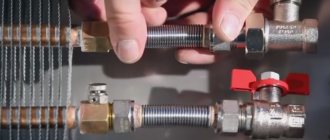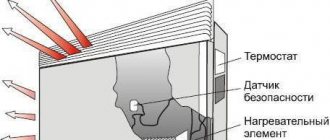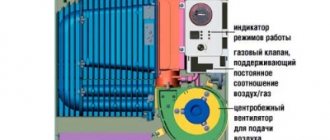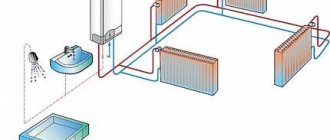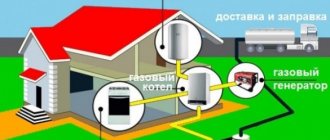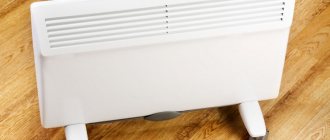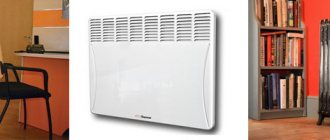When you are just deciding what kind of heating system to install in your apartment or house, you can easily fall for advertising from marketers and store managers who will describe in colorful terms all the advantages of this type of heating as in-floor convectors.
This article will discuss in detail all their shortcomings, which are usually modestly kept silent in all stores and on manufacturers’ websites.
Connection to central heating
Firstly, trench convectors are not compatible with central heating. And it doesn’t matter what connection diagram you have:
- single-pipe
- or two-pipe
You will not achieve normal operation with any of them. This is due to the fact that inlet and outlet pipes are laid along intricate and complex routes.
And in all these joints, turns and elbows, increased hydraulic resistance occurs.
Hot water does not want to follow a complex path with many joints and narrowings. It is much easier for her to bypass the convector and directly slip into another room or through the wall to your neighbors. That is, where normal radiators are installed and normal resistance is created.
As a result, your convectors remain cold. Of course, you can use a trick and, with a single-pipe system, plug the bypass.
This will ensure a forced supply of hot water. However, everything you achieve will be similar to the effect of installing a water floor.
It will be hot in your apartment, and all your closest neighbors will be sweltering.
Accordingly, expect complaints to all authorities. Next, commission checks. Instructions that at your own expense, within 3 days, you need to restore the normal circuit and operation of the central heating system.
And if you make a preliminary calculation and select the right material (section and diameter of plastic pipes, slide-on fittings), will the convector work in this case? Yes, it will.
However, not all models will heat normally, but only the most powerful of them, and even those that have a separate fan in their design.
But even in this case, the installation and installation of in-floor convectors, from the point of view of legislation, still falls under the same rules as the installation of water heated floors.
That is, connecting them from the central heating system is strictly prohibited.
Therefore, prepare in advance for inspections, bribes, fines, orders and similar headaches.
In addition, if you connect from the risers and go with pipes under the screed, the risers will still remain.
And you will have to get out in two ways:
- cover them with flooring
- erect a false wall
Therefore, the main thing you must remember is that if you have a standard heating system, then you should immediately forget about in-floor convectors .
Advantages
The main advantages of in-floor water convectors:
- low inertia and high heat transfer of the equipment ensure quick warm-up;
- efficient heating mode and maintaining a stable temperature;
- reliability and durability, warranty period - 10 years;
- simple design, ease of installation;
- operational safety - the temperature of external surfaces does not exceed 43 0 C;
- do not clutter the room and do not require space for installation;
- the ability to choose a radiator to suit any interior;
- the price is cheaper than European analogues;
- light weight;
- availability of spare parts;
- heating with mode control.
Installation depth in floor and fan
Now let's consider a situation where in your apartment the collector wiring and heating are done on the floor.
Firstly, do not take the word of sales managers. Absolutely all in-floor convectors heat very poorly. And the shallower the depth of their installation, the worse they do it.
In fact, in central Russia, only the most powerful models with an installation depth of 120 mm work normally. And only if they have an additional fan.
That is, specimens with a depth of 80 and 100 mm practically do not work in latitudes with cold temperatures.
From such work you will get foggy windows, and the temperature in the room will not exceed 17 degrees.
Sometimes there is even mold on the walls and ceiling.
But still, there are those that more or less work (with a fan and a depth of 12cm). Let's look at them.
Let's start with the fact that the presence of a fan is:
- additional troubles with electrics on the floor
- additional problems with turning it on and off
- extra electricity costs
- and most importantly, the constant noise from its operation
If you want a silent and quiet fan, then don’t be surprised at the price. For such models it starts from 50 thousand. rubles and reaches 200 thousand.
If we take the same ordinary radiator battery for comparison, then with the same heat transfer parameters, all your costs will be limited to 5 thousand.
At the same time, the fan itself is a very short-lived thing. No convector manufacturer provides a warranty of more than 1 year.
It is also very difficult to find manufacturers who sell fans separately. This means that if it breaks, you will most likely have to buy the whole convector again.
Design and principle of operation
The main components of the convector: a housing made of aluminum, stainless, galvanized steel, a heat exchanger and a protective and decorative grille made of wood, aluminum or steel. The heat exchanger is made of steel, copper, copper alloys, and aluminum plates are welded to it to increase the heat transfer surface.
Heating devices with forced convection are equipped with one or more fans and automatic control devices.
The convector is built into a niche on the subfloor or in a cement screed, leveled and fixed with mounting bolts and adjustable feet.
The air heated by the in-floor converter rises to the ceiling along the adjacent wall, moves to the opposite wall, cools, descends to the floor and re-enters the unit housing. A circulation occurs - convection - the room warms up quickly and evenly. Warm air flows rising from the device create a thermal curtain in front of the cold external wall and prevent windows from fogging up.
Screed thickness and floor level
If your screed thickness throughout the apartment is approximately 5 cm, then to install an in-floor convector, you will have to add as much as 7 cm on top.
And this is approximately 3 bags of mixture per 1 m2. Or 320 bags for an apartment of 100 m2.
As a result, you will receive neither more nor less - 13 tons of screed. A regular Gazelle contains approximately 1.5 tons.
And bringing almost 10 Gazelle screeds into your apartment just to install an in-floor convector is not a very smart decision.
In addition, do not forget that the floor level at the entrance to the apartment and the floor level at the entrance should be approximately the same level. That is, upon entering your home, you should not fall into a hole and should not climb a step.
This means that in approximately 70% of apartments, you simply cannot pour the required amount of screed to install the 120th box.
Additional heating
Specialists can also talk about additional heating. What is meant? -warm floors, warm walls, someone leaves some of the heating devices and wants to install a convector only to prevent fogging of the continuous glazing. Maybe the windows overlook a loggia or balcony, this also needs to be indicated.
If you decide to combine, for example, leave one battery or install a water or electric heated floor, then you need a less powerful convector, which will allow you to save on its cost and the complexity of laying communications.
Convector leakage
If your regular radiator is leaking, you will notice it immediately because you will see a puddle underneath it.
And if the underfloor convector leaks, you will discover it only after the entire laminate gets wet and the water rises above its level.
In this case, all neighbors below are guaranteed to be flooded.
When a regular radiator has leaking connections, what do you do? Take a regular adjustable wrench and calmly tighten them.
And when the convector leaks, all connections will be covered with very hot and very opaque water. And soaking this water with a rag is very inconvenient.
Radiators have very sharp edges and when you get water out of there, you are guaranteed to get cuts on your fingers.
Also, do not forget that only convectors with a fan heat properly. A fan is an electrical device that is powered by a voltage of 220V.
And in the case of a leaking convector, the effect will be quite obvious, as if the electrical wiring had been stuck in water.
Also, dirt and dust constantly accumulate in the niche of in-floor convectors, and cleaning there, as we found out, is not very convenient.
Nuances of installing a water convector
You can choose any type of heating device. In order for it to work for a long time and effectively, it is necessary to carry out competent and skillful installation. The work itself is not particularly difficult - just follow the instructions carefully. You don’t have to build anything in; this only applies to in-floor models. Water convectors are installed according to the same principle as conventional heating radiators.
During the work, professionals recommend following the following recommendations:
- If floor-standing equipment is connected to a water heating boiler, it is imperative to use a hydraulic arrow and a circulation pump.
- After the system is filled with water, the air is bled from it. For this purpose, the device includes special valves.
- Each piece of equipment must have a thermostat. With its help, heating and heating intensity are controlled.
- If classic radiators are replaced by modern convectors, then the power of previously installed units must be taken into account. The equipment must be identical.
- Special models specially designed for such conditions are installed in bathrooms, saunas and other rooms with high levels of humidity.
- During transportation and installation, the device body must not receive mechanical damage. Impact can cause microcracks, which will significantly reduce performance.
As you can see, nothing complicated should arise during the work. And yet, if the skills are not enough, it is better to turn to qualified specialists who will take into account all the subtleties. Read the Ferroli boiler on our website.
Convectors and laminate
Also, the installation of these heating devices is a gross violation of laminate laying technology.
Laminate, to the surprise of some, is not always of high quality. And even among premium brands there are defective batches.
For example, the decorative coating peels off and bends upward.
If he is married, you have the right to call an expert. And not from the supplier, but directly from the manufacturer.
He will check everything, and if the batch is truly defective, they must replace it with a new one free of charge.
And if you installed an in-floor convector, then you can immediately forget about warranty claims.
The expert will come, look at this matter, turn around, and, happy that they don’t have to change anything, go back.
Laminate is a “free-floating” flooring, and by installing such a heater in the floor, you do not give it the opportunity to expand in all directions.
Also, do not forget that laminate not only expands, but sometimes also contracts. Very often it shrinks so much that it no longer even covers the baseboard, which previously covered it by 1.5 cm.
And the decorative sides of the convector are only 5mm wide.
Therefore, in every second apartment, there are either wide gaps around the installation box, or the box is compressed and tightly clamps the decorative grille.
How to choose a heating device by power
Step one is to determine the heat energy requirement for each room. Calculated according to SNiP or a simplified method - 0.1 kW per 1 m² of area. The choice of electric convectors is simple; the thermal power of each modification is indicated in the passport.
Table from the instructions for the electric convector from the Ballu brand
Choosing and buying a water floor heater is more difficult. The technical characteristics of the device indicate heat transfer under certain conditions, for example:
- t (temperature) of water in the supply pipeline – 75 degrees;
- return t – 65 °C;
- air t in the room – 20 °C.
If you send a coolant with a temperature of 60 °C into the convector, its power will decrease; you need to take the device with a certain reserve. To accurately determine the heat transfer value of a specific model, you should use the manufacturer’s data; there are no other options.
Reference. The Verano company publishes in the equipment data sheets a table of the power of each heating device under various operating conditions. Let us give an example of such a table for a convector with a height of 300 mm and a width of 284 mm.
The heat transfer of a convector of a specific size depends on 3 temperatures: water in the supply/return line and room air.
Since the range of convection-type heaters is quite wide, it is unrealistic to lay out the technical parameters of all devices here. Therefore, to select the size of the convector, it is better to contact an online store consultant or visit the manufacturer’s official website.
Subtleties of convector care
During operation, the inner surface of the housing and the heat exchanger become contaminated with small particles of dust, crumbs and other household debris. To prevent the device from deteriorating, regular cleaning is recommended.
The procedure does not require much time and effort. It is enough to remove the grille that releases air, and then carefully wipe it with a soft sponge or vacuum the inner surface using a special nozzle.
The top of the body can be wiped down at least every day, but this must be done without aggressive chemical compounds.
Which type of grating do you prefer?
When choosing a heating device built into the floor, pay special attention to the grille. This element has a decorative role, as it remains above the floor.
The grating can be made of the following materials:
- galvanized, stainless or ordinary steel;
- anodized aluminum;
- natural marble;
- wood - beech, ash, merbau, oak, etc.
When choosing a material, it is necessary to take into account that the system must fit harmoniously into the interior and correspond to the design of the room.
Based on their design, there are 2 types of grilles for in-floor convectors:
- rolled - grilles are more expensive and easier to use, since they can be rolled up;
- linear - must be fully raised.
The slats in roll-up grilles are located exclusively across. In a linear design, they are located across and along the heating device.
Decorative grilles are a stylish completion of an underfloor heating system. They will help hide the ventilation and heating device
The design of the grate is especially important if people will step on it from above. In this case, you need to pay attention to the appearance and materials used in manufacturing. You should check that the grille does not contain any plastic parts, which manufacturers sometimes use at the junction of the frame and slats.
To evenly distribute the load on the device, reduce noise levels and increase comfort, some manufacturers install springs at the junction of the frame and the lamella.
In conditions of increased load, it is better to choose a grille that has the same design on both sides. If it wears off, it can be turned over for further use.
How to choose the right equipment?
In order not to make a mistake in choosing and buying the best floor-type heating water convector, many criteria are considered. First you need to allocate a place for the heater and measure it. Having written down the linear dimensions, you can go shopping for the device.
Main signs of quality
The first thing that is recommended to evaluate is the appearance of the product. It is important to pay attention to whether the declared characteristics meet the required parameters.
You should also check whether the device meets the basic quality criteria:
- the heat exchanger is made of durable metal that holds its shape well;
- The main material of the product is stainless steel, which is not subject to deformation and corrosion;
- the device body is as rigid as possible, covered with a dense layer of impact-resistant enamel, which has no bubbles or rough areas;
- all edges of the equipment are smooth and undamaged.
It is also worth considering that quality products are provided with a warranty from the manufacturer. It is advisable that its term be at least 5 years.
Mandatory selection criteria
After the external assessment, the analysis of mandatory criteria should begin. To choose the most efficient floor convector, take into account the individual characteristics of the room.
To begin with, we need to determine the following nuances:
- autonomous or central heating system in the room;
- the desired temperature regime to be maintained;
- the presence of equipment in the room and the amount of heat generated by it.
The operating pressure of the convector depends on the type of heating system in use. Its range is 2-12 atmospheres. To connect to a centralized system, at least 12 atmospheres of pressure are required.
The power of the device is calculated based on the general temperature in the house and the amount of heat generated by any household appliances installed in the room.
And also when calculating the optimal power of a water floor convector, the glazing area, the level of heat loss and the thickness of the walls are taken into account. There should be about 100 watts of power per square meter. This figure is average and may differ in a particular case.
For complete heating in large rooms, several floor heaters are installed, placing them around the entire perimeter
The devices operate on an electric motor that requires direct or alternating current. If the humidity level in the room is above average, it is better to choose electric motors that use alternating current.
Read on to learn more about the features of selecting electric heating convectors.
Compared to other devices, they are more resistant to water. In other cases, it is more advisable to take a convector with a DC motor - it is twice as economical.
Review of the best equipment manufacturers
You definitely cannot buy a floor convector from a dubious company. It is better to opt for products from reliable, proven companies with an optimal price/quality ratio. The brands Jaga, Minib, Polvax, Kermi are characterized by numerous positive reviews.
Kermi is a German company that produces floor convectors with side and bottom connections. The devices operate on different types of convection.
They are equipped with sensitive dynamic regulation, thanks to which the room maintains an average comfortable temperature. Products with a fan are characterized by particularly high power.
Kermi convectors can be designed as benches or equipped with an additional shelf on top. This move adds functionality to the product and makes it interesting from a design point of view.
Some models have a built-in thermal radiation screen that minimizes heat loss in rooms with a large glass area by 80%. The devices have a longitudinal or roll-up decorative grille and are made in classic and unusual shapes, emphasizing the individuality of the interior.
The standard color is satin, but upon request the manufacturer produces equipment in any color from the proposed palette.
Jaga is a floor-mounted heating device from a Belgian brand. They are distinguished by decent thermal conductivity and power. The company produces models equipped with a fan unit and standard options that operate on natural convection.
Each Jaga product is unique in design and performance. There are a lot of options for designing a steel or wooden box: flat, panel, bench-shaped. There is also a huge selection of colors and surface textures
Many of the company's products are equipped with a thermostat and an air release valve. The production uses a special technology that reduces water consumption during operation.
Among the proposals of the Czech company Minib there are heating equipment of various sizes and shapes, heating the space due to natural or forced air convection/
The equipment is made in a strict classic design. There are plenty of color options: you can choose silver, bronze, white and other shades from the palette.
The Minib assortment includes original products in a wooden case. The manufacturer offers a large selection of removable decorative grilles made of wood and aluminum
Minib convectors quickly react to a drop in temperature and immediately automatically increase their performance. They can easily heat large residential and non-residential premises.
The main advantage of the products is minimal energy consumption. The range includes a separate model with a thermoelectric generator that does not require power. This is one of the most economical solutions.
Convectors from the famous Polish manufacturer Polvax operate in natural convection mode. The company's assortment includes models with one, two and four heat exchangers made of high-quality copper and aluminum.
The standard version of Polvax equipment is presented in a white steel case, but if desired, you can choose any shade, matching it to the design of the room
The devices fit perfectly into modern interior styles. Their feature is an enlarged heat exchanger, good thermal power, and affordable cost.
Polvax floor-mounted water convectors heat any room. They are low, so they can be easily installed in rooms with low window sills and large panoramic windows.
Water heating convectors from the Ukrainian manufacturer Carrera are presented in a variety of design variations and sizes.
Devices with forced and natural convection are characterized by high heat transfer, not inferior to European brands.
A distinctive feature of Carrera products is their exquisite design and economical energy consumption
They remove condensate well and can be equipped with a drainage system, which is necessary in bathrooms, swimming pools, greenhouses and other wet areas.
Where are built-in heating systems used?
Floor-mounted convectors are innovative heating equipment that is distinguished by unique characteristics and stylish appearance.
They are recommended to be installed in the following cases:
- In rooms with large window openings , to eliminate the possibility of a draft in the room.
- In small rooms with a lack of free space or in those in which, according to the project design, there should be no unnecessary elements. The devices are built into the floor screed, leaving maximum space free.
- In rooms with high humidity levels, regardless of their purpose. Here their role is to provide a kind of curtain that prevents windows from fogging up.
In order not to be disappointed and avoid losing money, it is recommended to study information about the models you like before purchasing.
A properly selected heating device will definitely meet your expectations and will allow you to significantly save on energy consumption.
Conclusions and useful video on the topic
Visual installation process of a floor convector:
Information about the difference in the efficiency of forced and natural convection, which will help you decide on the choice of device:
A floor-type water convector is a safe, efficient and ergonomic heating method. It can be used in any room without any problems. If you carefully study the instructions with the manufacturer's recommendations, you can save a lot of money and handle the installation yourself.
Do you have personal experience using water floor convectors? Share it with visitors to our site. Tell us which equipment did you prefer? Are you satisfied with his work? Leave comments in the block below the article.
Basic Installation Recommendations
The installation process of a floor convector is quite simple. It is described in detail in the manufacturer's instructions. The equipment is installed on the floor by embedding or mounting on special legs-stands supplied in the kit. It is intended for use in enclosed spaces.
During installation, it is recommended to observe the following rules:
- mount the device in a strictly horizontal position, controlling this with an ordinary building level;
- carefully fix the equipment;
- make sure that the heat exchanger is located on the side farthest from the window (except for the case when the main mission of the convector is to create a protective heat shield along the windows);
- place the device at a distance of 20-25 cm from the floor covering;
- connect the heat exchanger to distribution pipes supplying the coolant, flexible hoses with a stainless steel coating or metal braided hoses.
- do not allow deformation of the gutter edges.
First of all, the floor surface is marked. Then the legs of the equipment or holders are fixed with special fasteners. After this, the housing is installed and the convector is connected to the water supply system.
Particular care should be taken when installing threaded connections. It is very important not to damage the threads or break the tightness of the clutches. It is best to use a torque wrench in your work, which will allow you not to exceed the tightening torque.
When installing the convector, you must follow the manufacturer's recommendations and connect the pipeline correctly. Installation errors can lead to insufficient efficiency and frequent breakdowns of the device.
Unlike devices with floor and wall mounting, floor convectors are distinguished by the simplest installation technique. But still, if you have insufficient skills and little experience in handling heating equipment, it is advisable to entrust the installation to a professional technician.
Types and features of equipment
The design of the electrical built-in unit is quite simple. It consists of a metal box housing, in the middle of which there is a heating element. To maximize heat transfer, it is equipped with convective fins. The top of the heater is covered with an aesthetic grille located at floor level.
In some cases, built-in convectors are installed in the window sill. This technique is practiced if in-floor heating devices are not enough to optimally heat the room
To increase the thermal power, some models are equipped with fans. They increase the speed of movement and heating of air by 75-90%. To reduce the noise generated by fans, special inserts made of porous rubber are used.
If large heating power is not required, the in-floor unit can operate with the fan turned off due to natural convection.
To achieve the optimal temperature in the room, temperature controllers and sensors are used, which are located in the middle of the metal case. Regulators can be electromechanical or electronic.
This unit controls the temperature and fan speed. Convenient “manual” control allows you to set the required parameters if necessary.
Convectors built into the floor can be equipped with a thermostat that shows the temperature, controls the process of coolant flow in the heat exchanger and the fan rotation speed
A heating device connected to a heating circuit differs from an electric one only in that instead of a heating element there is a pipe running inside it. By analogy, it is equipped with fins, the purpose of which is to increase heat transfer.
Water type floor convectors can also be equipped with fans to speed up the heating process.
Each element of an in-floor convector is made from different materials, has certain characteristics and performs its functions. Therefore, the quality and functionality of the heating device should be assessed based on the included accessories.
A thermostat is built in to regulate the temperature, and a fan is installed to increase the efficiency of the device.
What functions do convectors perform?
Due to the rapid popularity of these systems, you need to study all the existing functions of convectors to fully ensure that this system is suitable for heating your house or apartment.
Among the main functions of convectors are:
- Heating functions. The convector is designed to create heat in rooms. At the same time, this heating will not dry out the air.
- Prevention of fungi and dampness. This option exists if the system was installed near a window.
- Underfloor heating. This function allows the consumer to install the system on the floor, which will not take up much space and will look more aesthetically pleasing than conventional heating radiators.
Floor heating convectors that are built into the floor will look great in rooms designed in a minimalist style.
